SUITE OF ANTIQUE CORAL JEWELRY Comprising a bracelet, designed with a central carved coral floral and foliate cluster, attached to a coral brick link band, mounted in yellow gold (several leaves missing)--8 in. ; a tiara, en suite , mounted in metal (several leaves missing) ; a necklace, designed with a central carved coral floral and foliate cluster with detachable foliate pendant, attached to a triple strand of coral beads, with a yellow gold and coral clasp --18 in. ; a brooch, en suite , mounted in yellow gold (one leaf missing) ; and a waistband, designed with branch coral, mounted in yellow metal (solder evident, several branches missing)--23 in. (7) See illustration for bracelet and brooch Coral jewelry was worn extensively by ancient Romans who believed it to possess great supernatural powers. It was considered to be an antidote to poison and a talisman against enchantments and evil. During the nineteenth century, coral once again became popular and stylish as all things classical were revived and revered. Coral was worn in intricate parures with matching bracelets, brooches, hair combs and beads. This preference continued through the Victorian period with coral considered proper daywear and often rendered in naturalistic designs. Coral did not enjoy such popularity again until the Art Deco period which often paired it with jade and black onyx to give maximum contrast to each material. This suite of jewelry typifies the coral parures popular during the mid nineteenth century. The elaborately carved foliage, blooming flowers and fruit, as well as its deep rich orange red color, suggest that it may have come from Naples, Italy, which was then considered a main production center for such widely acclaimed articles of bijoux. It is purported that this suite of jewelry, purchased from a descendant of the Confederate General Joseph Wheeler, the only Confederate General buried in Arlington National Cemetery, probably belonged to his daughter, due to the size of the coral figural waist belt. It is remarkable and refreshing that such a historical piece remains intact. (5)
SUITE OF ANTIQUE CORAL JEWELRY Comprising a bracelet, designed with a central carved coral floral and foliate cluster, attached to a coral brick link band, mounted in yellow gold (several leaves missing)--8 in. ; a tiara, en suite , mounted in metal (several leaves missing) ; a necklace, designed with a central carved coral floral and foliate cluster with detachable foliate pendant, attached to a triple strand of coral beads, with a yellow gold and coral clasp --18 in. ; a brooch, en suite , mounted in yellow gold (one leaf missing) ; and a waistband, designed with branch coral, mounted in yellow metal (solder evident, several branches missing)--23 in. (7) See illustration for bracelet and brooch Coral jewelry was worn extensively by ancient Romans who believed it to possess great supernatural powers. It was considered to be an antidote to poison and a talisman against enchantments and evil. During the nineteenth century, coral once again became popular and stylish as all things classical were revived and revered. Coral was worn in intricate parures with matching bracelets, brooches, hair combs and beads. This preference continued through the Victorian period with coral considered proper daywear and often rendered in naturalistic designs. Coral did not enjoy such popularity again until the Art Deco period which often paired it with jade and black onyx to give maximum contrast to each material. This suite of jewelry typifies the coral parures popular during the mid nineteenth century. The elaborately carved foliage, blooming flowers and fruit, as well as its deep rich orange red color, suggest that it may have come from Naples, Italy, which was then considered a main production center for such widely acclaimed articles of bijoux. It is purported that this suite of jewelry, purchased from a descendant of the Confederate General Joseph Wheeler, the only Confederate General buried in Arlington National Cemetery, probably belonged to his daughter, due to the size of the coral figural waist belt. It is remarkable and refreshing that such a historical piece remains intact. (5)
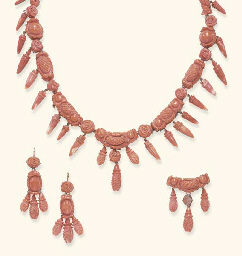
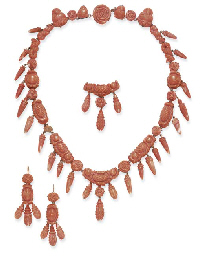

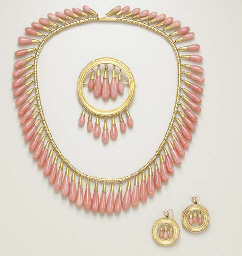




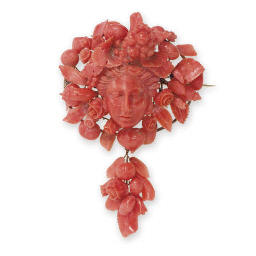


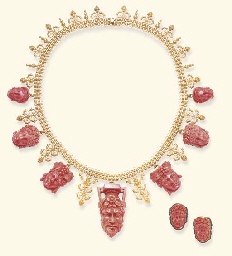



Try LotSearch and its premium features for 7 days - without any costs!
Be notified automatically about new items in upcoming auctions.
Create an alert